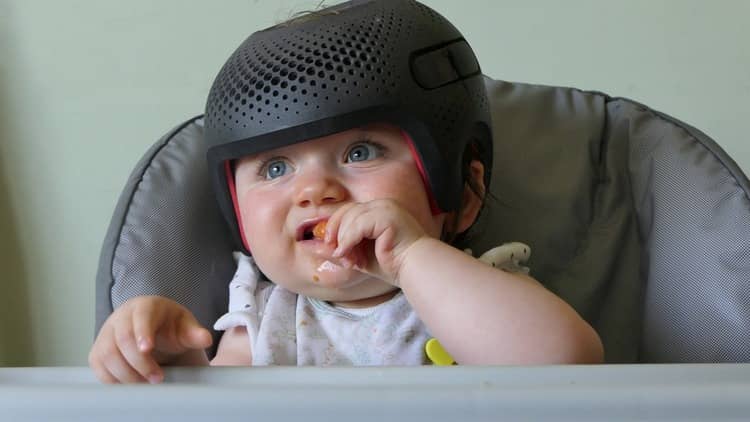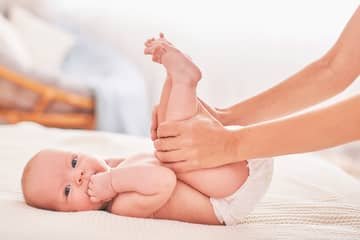
Cranial orthosis - Remodeling helmet for flat head
The proper growth of children requires careful attention from parents at every stage of their development. It is necessary to start already at the beginning of their life, i.e. from their birth. In the period of the first year of life, the baby gradually strengthens the muscles necessary for taking up positions on its own, such as lying on the stomach, on the sides, and finally the sitting position. However, until he acquires these abilities, the infant tends to stress certain areas of the head, which can lead to their lying down, which is also contributed to by the soft skull of newborns. If parents do not pay attention to this area of the child's development through positioning, it can develop into a problem that can potentially correct the so-called cranial orthosis.
What exactly is a cranial orthosis, in what cases is it used and on what principle does it work in influencing the correct growth of a child's skull, we will discuss in our article dedicated to the relevant issue. We will also state how long the helmet should be worn on a tilted head and who is in charge of prescribing it.
A child's skull requires extreme attention
As we already indicated in the introduction, the skull of newborns is characterized by an excessively pliable structure that enables the growth of the most important human organ - the brain. A newborn's skull consists of soft plates with empty spaces between them.
As the child grows, individual plates grow with him, gradually acquire hardness and fuse into a single unit. During this growth process, it is therefore excessively susceptible to deformation, which may lead to aesthetic disadvantages in the future, which the child often perceives as a personal flaw.
Depending on the degree of skull deformity, there may also be difficulties in wearing glasses or bicycle helmets. The listed inconveniences in the form of aesthetic defects are mostly the result of mild to moderate deformities, while the severe ones already have more serious consequences in the form of a negative impact on the development of the child's brain.
It is therefore very important for parents to pay enough attention to the positioning of their baby in the state of sleep and wakefulness, because this is the only way to prevent any form of skull deformation arising during the child's development.
Although in many cases a complicated birth requiring the use of gynecological forceps has a negative effect on the shape of the newborn's skull, sometimes improper growth of the skull already occurs during the development of the fetus in the womb. The cause of this phenomenon can be e.g. multiple pregnancy.

What is a cranial brace?
While mild to moderate pressure ulcers in children can potentially be corrected with careful positioning, more severe cases require intervention in the form of a prescribed cranial brace. Remodeling orthosis designed to eliminate deformations of the newborn skull may remind someone in certain aesthetic aspects of a helmet intended for boxers.
Primarily, one can get the feeling that it is heavy from a helmet on a flat head, but the opposite is true. Thanks to its weight of around 150 grams, it is a helmet that does not burden the developing baby's cervical spine in any way, so there is no need to worry that wearing it will deform other important parts of the baby's body.
The cranial helmet in no way restricts the child's movement. It is therefore not uncomfortable or dangerous for the baby. Its most important function is to guide the growth of the skull, which is forced to adapt to the shape of the orthosis itself.
The ideal combination of safety and efficiency lies in the construction of the helmet. While the hard outer shell of the helmet helps with proper shaping, the foam lining is responsible for safety and comfort.
From the point of view of the time horizon, it is advisable to apply it as soon as possible, i.e. at a time when the skull is sufficiently pliable and easily shaped due to the influence of the cranial orthosis. The length of treatment depends on the severity of the particular case of cranial deformation.
The course of treatment with a helmet for a tilted head
It is best to start the treatment between the 4th and 18th months of the baby's life, while its recommended completion can be suggested by an orthopedist, a surgeon, but also a rehabilitation specialist. This decision is made if, during the examination of the baby, an asymmetry of the skull in the range of eight millimeters or more is detected.
In the first phase of the four-month treatment, there is a visit to a specialized center. In Slovakia, such medical facilities are located, for example, in Bratislava or Martin. A comprehensive diagnosis of the baby's cranial deformity will take place in the appropriate treatment center. The examination is carried out using 3D technology with the function of a medical scanner.
On the basis of the obtained information and dimensions from the created images, a cranial orthosis adapted to the exact anatomy of a specific child will be made precisely within two weeks in order to prevent any skin complications.
The beginnings of wearing a cranial brace can be difficult. Since the child may not like the aid on the head, it is ideal that almost every company offering custom-made helmets for folded heads has a certain system to help the child get used to the medical helmet. Such instructions for using the cranial orthosis eliminate potential skin problems.
The course of treatment, of course, requires regular examinations, which consist in checking the correct growth and formation of the skull due to the impact of the helmet on the head. Control health examinations are required every three weeks. The final treatment phase consists in 3D visualization of the original and resulting shape of the skull.
Complete termination of treatment is possible only with the consent of the supervising physician. It is therefore not recommended under any circumstances to arbitrarily interrupt the treatment process using a cranial orthosis. Such a decision can negatively affect the results achieved, putting the child's development at potential risk.

The principle of treatment with a remodeling orthosis
The cranial orthosis works on the principle of exerting gentle persistent pressure on the baby's soft skull in order to prevent further growth in areas with a certain growth lead and at the same time allow the development of flat, folded parts of the skull. During check-ups, certain orthosis adjustments are made depending on the progress of cranial growth in the right direction.
The helmet for the baby's head lying down creates the necessary and shape-adjusted space for optimal head development, while preventing any further deformation of the skull in case the baby still prefers to lay the head on the lying side.
Cranial orthosis and possible problems
A potential problem, especially in the beginnings of wearing a cranial orthosis, can be excessive sweating on the head of a child who is not used to extensive wearing of a head covering indoors. Over time, the skin of the child's head will get used to the helmet and the sweating should decrease.
However, if this problem occurs, it is important to remove the helmet from the head and thoroughly dry the skin together with the hair. Before putting the helmet back on, the inside of the medical device should also be dry.
If you plan to cut the baby's hair, the optimal solution is to leave at least a thin layer of hair on the surface of the head. Completely shaving a child's head in combination with a tight helmet can have a negative impact on the child's skin.
Depending on the volume of the child's hair during the treatment, the degree of size and shape accuracy changes, which can affect the correct growth of the skull. It is therefore recommended to maintain a constant length of hair on the baby's head while wearing the cranial orthosis.
Under no circumstances should the child be without a helmet for more than 48 hours during the treatment process. Since the baby's head is constantly developing, such a misstep can also affect the way the hat fits the baby's head. In the event that any problem occurs that prevents the wearing of a cranial orthosis, it is advisable to seek the help of an expert.

Cranial orthosis - experience
Moms on the discussion forums agreed that in the case of a cranial orthosis, it is an effective way of treating deformities of the skull of a growing child. The discussion posts also show the fact that you don't always have to rely on the recommendation of a pediatrician, who in some cases will recommend positioning the head with the words: "it will disappear with time".
Mothers should solve this problem of their own volition, especially when the drooping of the head is pronounced and visible to the layman's eye. Sometimes, however, the process of making a cranial orthosis is more lengthy, and it may happen that the mother begins to notice a certain improvement in the child's head.
If the treatment has already started, it is necessary to take the child to the relevant medical center for a check-up, so that the relevant experts can also check the situation, who, based on their own knowledge and skills, will assess whether the continuation of the treatment is necessary or whether it can be stopped completely.
The most frequent questions - FAQ
Have you read our article on the treatment of children's skull deformities with a cranial orthosis, but you still have some questions hanging over your head? Feel free to refer to our Q&A section, where we have summarized several other important aspects related to this issue. For other comments, which we try to answer as soon as possible, there is a comment section for our readers.
Is the cranial orthosis also suitable for a baby with milder bedsores?
Which medical facility in Slovakia has the option of treating deformities of the child's skull with a cranial orthosis?
Does a child have to wear a remodeling helmet 24/7?
What about the price of the remodeling orthosis?
Pridať komentár






